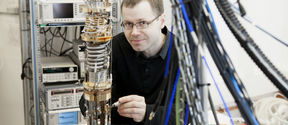The career of Aalto University Professor Mika A. Sillanpää can be characterized as a series of breakthrough accomplishments in the esoteric arena of quantum physics.
His research challenges conventional thought. Sillanpää was the first in the world to connect two superconducting qubits via a quantum bus into a quantum superposition state. He has proven that quantum entanglement can be achieved in the macroscale, simultaneously showing how the Heisenberg uncertainty principle can be circumvented.
More recently, Sillanpää has set out to demonstrate quantum gravity, which would effectively unify quantum mechanics and Einstein’s theory of general relativity—a task with significant implications, but formidable experimental challenges.
But Sillanpää has not been one to shy away from challenges in the past. Cautioning against overhyping the flashy concepts behind new quantum technology, Sillanpää said it is necessary to prioritize this type of pioneering, fundamental research.
‘Similar to nanotechnology in the early 2000s, the portrayal of quantum technology in popular media, specifically quantum computers, contains aspects of sensationalism,’ Sillanpää says. ‘There will be useful quantum computers. The next big task for us physicists in fundamental research is merging quantum mechanics with general relativity.’
And now, he will be able to continue his research with a new title: Sillanpää was promoted to full professor at Aalto University in July.
GUANTUM project
Two tiny gold spheres lay on opposing sides of a thin membrane. Measuring a mere 0.5 millimeters in diameter and weighing one milligram each, these spheres could be the catalyst for demonstrating gravitation at the quantum level.
‘Experimentally, it is exceedingly difficult. Having a couple of little black holes in the lab would be tremendously helpful,’ Sillanpää says. ‘Seeing that black holes are not yet commercially available, we have to work with what we have.’
Comparatively, the smallest scale that gravitational influences have been measured is roughly 100 times the mass of the spheres in Sillanpää’s experiments. Even then, the motion was not governed by quantum mechanics, which is the primary focus of the GUANTUM project.
‘On paper, it should be doable, and I believe it can be accomplished in five years,’ Sillanpää says. ‘But we are now taking the first steps towards demonstrating true quantum gravity—a concept that may not be fully realized in my lifetime.’
This is the work that has earned Sillanpää the European Research Council’s advanced grant of €2.5 million. As part of the research, the gold spheres will act as sensitive oscillators in a quantum-mechanical state. It is an extremely closed system where phenomena unseen in classical physics may occur. At the same time, they will observe the very small gravitational forces, which cause the gold spheres to be attracted toward each other.
Continuing work at Aalto
While not busy with the GUANTUM project, Sillanpää leads the Quantum Nanomechanics research group, which, besides the main focus on fundamental research, has been hard at work developing quantum mechanical devices—a product of their research that has wide-ranging applications in the greater field of quantum technology.
Having begun his physics professorship at Aalto in 2012, Sillanpää has hands-on experience with much of the growing body of research infrastructure housed under OtaNano, which is paramount for he and his team to be able to conduct necessary experiments.
‘The Otanano equipment is absolutely critical for our research; we use almost nothing else,’ Sillanpää says. ‘Between the clean rooms and the cryostats, this essential technology enables us to conduct this very important fundamental research.’
Operated by Aalto University and VTT, OtaNano is comprised of the Low Temperature Laboratory, Micronova and the Nanomicroscopy Center. The OtaNano research infrastructure houses comprehensive micro- and nanofabrication facilities in clean-room environments, high-resolution imaging and characterization equipment, and state-of-the-art experimental facilities, including ultra-low temperature possibilities.







